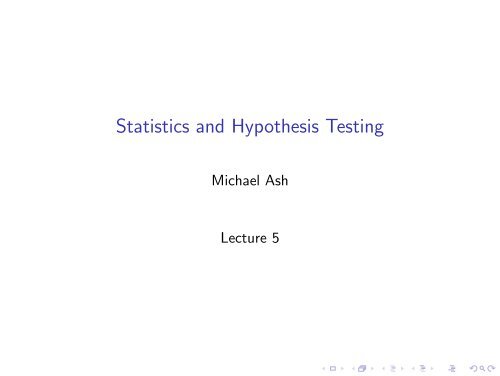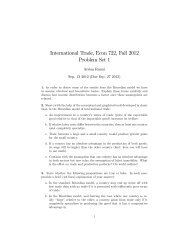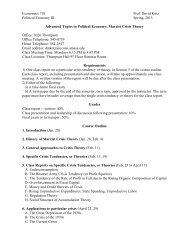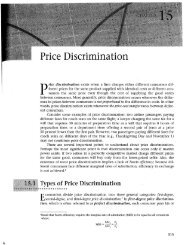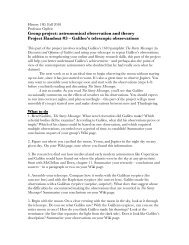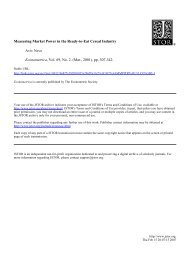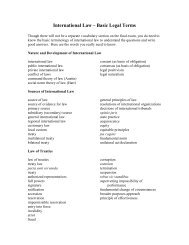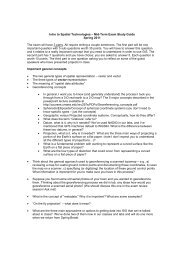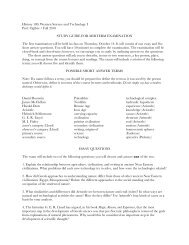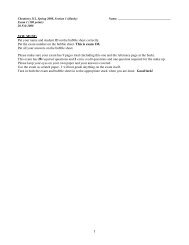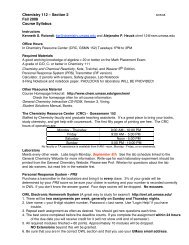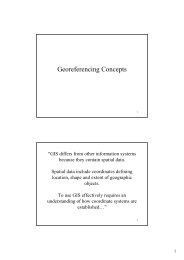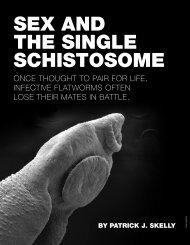Statistics and Hypothesis Testing
Statistics and Hypothesis Testing
Statistics and Hypothesis Testing
Create successful ePaper yourself
Turn your PDF publications into a flip-book with our unique Google optimized e-Paper software.
<strong>Statistics</strong> <strong>and</strong> <strong>Hypothesis</strong> <strong>Testing</strong><br />
Michael Ash<br />
Lecture 5
But first, let’s finish some material from last time.
Summary of Main Points<br />
◮ We will never know population parameters µ Y or σY 2 , but we<br />
will use data from samples to compute estimates Y <strong>and</strong> sY<br />
2<br />
<strong>and</strong> statistical theory to judge the quality of the estimates<br />
for addressing real-world questions.<br />
◮ Statistical knowledge is couched around hypothesis testing:<br />
will the sample data permit us to accept a maintained<br />
hypothesis or to reject it in favor of an alternative<br />
◮ We will use the sample mean to test hypotheses about the<br />
population mean. What are some conequences of the focus on<br />
the mean
What is an estimator<br />
An estimator is a method of guessing a population parameter, for<br />
example, the population mean µ Y , using a sample of data. The<br />
estimate is the specific numerical guess that an estimator yields.<br />
Estimators of a parameter are indicated by inserting aˆ . For<br />
example, guesses about the population mean are labeled ̂µ Y
What would be a good way to guess µ Y <br />
One method of guessing the population mean is to take a sample<br />
<strong>and</strong> compute the sample mean: Y = ∑ n<br />
i=1 1 n Y i. Another way<br />
would be to take whatever observation happens to come first on<br />
the list, Y 1 (or last Y n ).
Why is Y a good estimator of µ Y <br />
Unbiased We showed last time that E(Y ) = µ Y (“on average, the<br />
sample mean is equal to the population mean”), which is<br />
the definition of unbiasedness. (Note, however, that<br />
unbiasedness also holds for using the first observation Y 1<br />
as the estimator of µ Y : “On average, the first observation<br />
is equal to the population mean.”)<br />
Consistent Y becomes closer <strong>and</strong> closer to (a better <strong>and</strong> better<br />
estimate of) µ Y as the sample size grows. (Note, by the<br />
way, that Y 1 does not become a better estimate of µ Y as<br />
the sample size grows.)<br />
Most efficient Y has variance σ2 Y<br />
n<br />
, which turns out to be the lowest<br />
possible variance among unbiased estimators of µ Y . (Note<br />
that Y 1 has variance σY 2 , which is terrible by comparison.)<br />
The book demonstrates that Y , which equally weights<br />
each observations in ∑ n<br />
i=1 1 n Y i, has lower variance than<br />
alternative weightings of the data. Alternative weighted<br />
averages of all the data are better (lower variance) than<br />
Y 1 but not as good as Y
Y is the least squares estimator of µ Y<br />
Suppose that the data Y 1 , Y 2 , . . . , Y n are spread along the number<br />
line, <strong>and</strong> you can make one guess, m, about where to put an<br />
estimate of µ Y .<br />
Y<br />
i<br />
The criterion for judging the guess will be to make<br />
n∑<br />
(Y i − m) 2<br />
i=1<br />
as small as possible. (Translation: square the gap between each<br />
observations Y i <strong>and</strong> the guess <strong>and</strong> add up the sum of squared<br />
gaps.) If the guess m is too high, then the small values of Y i will<br />
make the sum of squared gaps get big. If the guess m is too low,<br />
then the big values of Y i will make the sum of squares gaps get<br />
big. If m is just right, then the sum of squared gaps will be as<br />
Y<br />
i
Y is the least squares estimator of µ Y<br />
It turns out that Y , the sample mean, is the best guess (the guess<br />
that makes the sum of squared gaps as small as possible).<br />
Choosing m = Y makes the following expression as small as<br />
possible.<br />
n∑<br />
(Y i − m) 2<br />
i=1<br />
We will use this method (keeping the sum of squared gaps as low<br />
as possible) for defining the best guess again soon.
R<strong>and</strong>om Sampling<br />
The consequences of non-r<strong>and</strong>om sampling<br />
1. Non-r<strong>and</strong>om samples<br />
◮ Convenience samples <strong>and</strong> how hard it is to avoid them<br />
◮ The Literary Gazette, L<strong>and</strong>on, <strong>and</strong> Roosevelt.<br />
◮ Nonresponse bias<br />
◮ Attrition bias<br />
◮ Purposive sampling (e.g., for qualitative research)<br />
2. High quality surveys<br />
◮ Current Population Survey
<strong>Hypothesis</strong> <strong>Testing</strong><br />
With statistical methods, we can test hypotheses about population<br />
parameters, e.g., the population mean. For example: Does the<br />
population mean of hour earnings equal $20 per hour<br />
◮ Define the null hypothesis<br />
H 0 : E(Y ) = µ Y ,0<br />
H 0 : E(hourly earnings) = $20 per hour<br />
◮ Define the alternative hypothesis.<br />
H 1 : E(Y ) ≠ µ Y ,0<br />
H 1 : E(hourly earnings) ≠ $20 per hour<br />
◮ Gather a sample of data <strong>and</strong> compute the actual sample mean
<strong>Hypothesis</strong> <strong>Testing</strong><br />
1. Gather a sample of data <strong>and</strong> compute the actual sample mean<br />
2. If the null hypothesis were true, would the r.v. the sample<br />
mean likely be as big (or small) as the actual sample mean<br />
[ ∣∣Y ∣ ∣ ∣]<br />
Pr − µY ,0 ∣∣Y act ∣∣ > − µY ,0<br />
H 0<br />
(There is only one r<strong>and</strong>om variable in the preceding<br />
mathematical phrase. Can you find it)<br />
2.1 If so (the probability is large), “accept the null hypothesis”<br />
(which does not mean that the null hypothesis is true, simply<br />
that the data do not reject it).<br />
2.2 If not (the probability is small), “reject the null hypothesis” in<br />
favor of the alternative.
Important Notes on <strong>Hypothesis</strong> <strong>Testing</strong><br />
◮ Summary of the hypothesis-testing approach<br />
1. The null hypothesis is a hypothesis about the population mean.<br />
2. The null hypothesis (<strong>and</strong> the size of the sample) implies a<br />
distribution of the sample mean.<br />
3. An actual sample of real-world data gives an actual value of<br />
the sample mean.<br />
4. The test of the null hypothesis asks if the actual value of<br />
the sample mean is likely under the implied distribution of the<br />
sample mean (likely if the null hypothesis is true).<br />
◮ We learn about the population mean. For example, if we learn<br />
that E(hourly earnings) > $20 per hour, this does not mean<br />
that every worker earns more than $20 per hour! Do not<br />
confuse the mean with the entire distribution.<br />
◮ Do not confuse statistical significance <strong>and</strong> practical<br />
significance. With a large enough sample, you can distinguish<br />
an hypothesized mean of $20 per hour from an hypothesized<br />
mean of $20.07 per hour. Does anyone care More on this<br />
later.
The p-Value<br />
p-value ≡ Pr<br />
H 0<br />
[ ∣∣Y<br />
− µY ,0<br />
∣ ∣ ><br />
∣ ∣∣Y act<br />
− µY ,0<br />
∣ ∣∣<br />
]<br />
This phrase expresses how likely the observed, actual sample mean<br />
Y act would be to deviate from the null-hypothesized population<br />
mean µ Y ,0 if the null hypothesis were true.<br />
Why can it deviate at all (if the null hypothesis is true) Sampling<br />
variation.<br />
But if the actual sample mean deviates “too much” from the<br />
null-hypothesized population mean, then sampling variation<br />
becomes an unlikely reason for the difference.
Defining “too much.”<br />
We know that under the null hypothesis, the sample mean is a<br />
r<strong>and</strong>om variable distributed in a particular way: N(µ Y ,0 , σ 2 Y ).<br />
Because this is a normal distribution, we know exactly the<br />
probability that the sample mean is more than any specified<br />
distance away from the hypothesized mean (if the hypothesized<br />
mean is accurate).<br />
For example, it is less than 5 percent likely that the sample mean<br />
will be more than 2 (really 1.96) st<strong>and</strong>ard deviations away from the<br />
hypothesized mean (if the hypothesized mean is accurate).
How likely is the observed value<br />
In words, the p-value is how likely the r<strong>and</strong>om variable Y is to<br />
exceed the observed actual Y act if the null hypothesis is true.<br />
As p falls, we become increasingly sure that the null hypothesis is<br />
not true. (It’s really unlikely that we could have a sample mean<br />
this big (small) if the null were true. We do have a sample mean<br />
this big (small). Ergo, the null hypothesis is not true.)<br />
Convert to a st<strong>and</strong>ard normal problem
Convert to a st<strong>and</strong>ard normal problem<br />
Y act ∣]<br />
− µ ∣∣∣∣<br />
Y ,0<br />
∣ σ Y<br />
Y act ∣]<br />
− µ ∣∣∣∣<br />
Y ,0<br />
∣ σ Y<br />
[<br />
Y act ∣]<br />
[<br />
− µ ∣∣∣∣ Y ,0<br />
Y act ∣]<br />
− µ ∣∣∣∣<br />
Y ,0<br />
= Pr Z < −<br />
+ Pr Z ><br />
H 0 ∣ σ Y<br />
H 0 ∣ σ Y<br />
[<br />
Y act ∣]<br />
[<br />
− µ ∣∣∣∣ Y ,0<br />
Y act ∣]<br />
− µ ∣∣∣∣<br />
Y ,0<br />
= Pr Z < −<br />
+ Pr Z < −<br />
H 0 ∣ σ Y<br />
H 0 ∣ σ Y Y<br />
= Φ H0<br />
(−<br />
act ∣)<br />
− µ ∣∣∣∣ Y ,0<br />
Y + Φ<br />
∣<br />
H0<br />
(−<br />
act ∣)<br />
− µ ∣∣∣∣<br />
Y ,0<br />
σ Y<br />
∣ σ Y = 2Φ H0<br />
(−<br />
∣<br />
[∣ ∣ ∣∣∣∣<br />
Y − µ ∣∣∣∣<br />
Y ,0<br />
p-value = Pr<br />
><br />
H 0 σ Y<br />
[<br />
= Pr |Z| > ∣<br />
H 0<br />
Y act ∣)<br />
− µ ∣∣∣∣<br />
Y ,0<br />
σ Y
Sample Variance, Sample St<strong>and</strong>ard Deviation, St<strong>and</strong>ard<br />
Error<br />
Why<br />
◮ The sample variance <strong>and</strong> sample st<strong>and</strong>ard deviation are<br />
interesting in their own right as a description of the spread in<br />
the data. Is income equally or unequally distributed Do<br />
winters vary from year to year<br />
◮ As we can estimate the population mean using the sample<br />
mean, we can estimate the population variance <strong>and</strong> st<strong>and</strong>ard<br />
deviation using the sample variance <strong>and</strong> st<strong>and</strong>ard deviation.<br />
◮ The sample variance <strong>and</strong> st<strong>and</strong>ard deviation of the underlying<br />
data are needed to estimate the variance <strong>and</strong> st<strong>and</strong>ard<br />
deviation of the sample mean. (We need the latter as a<br />
measure of how precisely the sample mean estimate the<br />
population mean.)
Sample Variance<br />
◮ An unbiased <strong>and</strong> consistent estimator of population variance<br />
sY 2 ≡ 1<br />
n∑<br />
( ) 2<br />
Y i − Y<br />
n − 1<br />
i=1<br />
◮ Definition of sY 2 is almost: compute the average squared<br />
deviation of each observation from the population mean. But:<br />
◮ The population mean µY is unknown; so instead we use Y ,<br />
the sample mean<br />
◮ Because we had to use the sample data to compute the sample<br />
mean Y , we used up one degree of freedom. So when we<br />
compute the average we divide by n − 1 instead of n.<br />
◮<br />
If we used n instead of n − 1, we would slightly underestimate<br />
the population variance. Note that the difference becomes<br />
small as the sample-size grows (Dividing by n or by n − 1 is<br />
not very different when n is very large.)
Sample St<strong>and</strong>ard Deviation<br />
The sample st<strong>and</strong>ard deviation is simply the square root of the<br />
sample variance <strong>and</strong> has the advantage of being in the same units<br />
as Y <strong>and</strong> Y . It is an unbiased <strong>and</strong> consistent estimator of the<br />
population st<strong>and</strong>ard deviation.<br />
s Y =<br />
√<br />
s 2 Y = √ √√√<br />
1<br />
n − 1<br />
n∑ (<br />
Yi − Y ) 2<br />
i=1
St<strong>and</strong>ard Error of Y<br />
Recall that the st<strong>and</strong>ard deviation of Y is denoted σ Y<br />
<strong>and</strong> equals<br />
σ Y / √ n.<br />
The st<strong>and</strong>ard error of Y is an estimator of the st<strong>and</strong>ard deviation<br />
of Y using nothing but the sample data:<br />
st<strong>and</strong>ard error of Y = SE(Y ) = ˆσ Y<br />
= s Y / √ n<br />
It is ok to substitute s Y for σ Y because s Y is a consistent<br />
estimator of σ Y .
Summary: Why st<strong>and</strong>ard error<br />
◮ Can be computed entirely from the sample data.<br />
◮ Expresses the expected spread in sample means if multiple<br />
samples were taken from the population.<br />
◮ Measures the precision of the sample mean as an estimate of<br />
the population mean.<br />
◮ Increases with the spread in the (sample) data, s Y , <strong>and</strong><br />
decreases with the sample size, n.
Practical <strong>Hypothesis</strong> <strong>Testing</strong><br />
Form a t-Statistic<br />
t ≡ Y act − µ Y ,0<br />
SE(Y )<br />
◮ µ Y ,0 comes from the null hypothesis<br />
◮ Y <strong>and</strong> SE(Y ) come from the data.<br />
t is approximately distributed N(0, 1) when the sample n is large.<br />
We will use the normal approximation for computing the p-value.<br />
p-value = 2Φ(− |t|)
The Prespecified Significance Level<br />
A st<strong>and</strong>ard in the social sciences is that a p-value below 0.05 is<br />
appropriate grounds for rejecting the null hypothesis. This<br />
corresponds to a t-statistics more than 1.96 (almost exactly 2)<br />
st<strong>and</strong>ard deviations away from zero.<br />
Reject H 0 if p < 0.05<br />
is equivalent to<br />
Reject H 0 if |t| > 1.96
Size of a test: probability of erring in rejection<br />
By pure sampling chance, one time out of twenty, or 5 percent of<br />
the time, the data will reject the null hypothesis even though the<br />
null hypothesis is true. For more sensitive matters than mere social<br />
science, a higher st<strong>and</strong>ard (lower p-value) may be required.
An example<br />
Is the mean wage among recent college graduates $20 per hour<br />
H 0 : E(Y ) = µ Y ,0<br />
H 0 : E(hourly earnings) = $20 per hour<br />
In a sample of n = 200 recent college graduates, the sample<br />
average wage, Y act = $22.64. STOP RIGHT HERE. Why doesn’t<br />
this prove immediately that the mean wage among recent college<br />
graduates is $22.64, obviously above $20
Average wage example, continued<br />
The sample st<strong>and</strong>ard deviation is s Y = $18.14.<br />
◮ Compute the st<strong>and</strong>ard error of Y<br />
SE(Y ) = s Y / √ n<br />
= 18.14/ √ 200<br />
= 1.28<br />
◮ Compute the t-statistic<br />
t = Y act − µ Y ,0<br />
SE(Y )<br />
22.64 − 20<br />
=<br />
1.28<br />
= 2.06<br />
Now how likely is it that our sample would generate a t-statistic of<br />
2.06 when we would expect a t-statistic of zero under the null<br />
hypothesis
Average wage example, continued<br />
◮ Compute the p-value<br />
p = 2Φ(−|t|)<br />
= 2Φ(−2.06)<br />
= 2(0.0197)<br />
= 0.039, or 3.9 percent<br />
Conclusion: it is fairly unlikely that the mean earnings among<br />
recent college graduates is $20 per hour given that our sample of<br />
200 had mean earnings of $22.64 (<strong>and</strong> st<strong>and</strong>ard deviation of<br />
$18.14). If we were using the conventional significance level of 5<br />
percent, we would reject the null hypothesis.
See Key Concept 3.5<br />
Statistical analogy to U.S. law (outdated)<br />
◮ Formulation <strong>and</strong> testing of the null hypothesis is equivalent to<br />
presumption of innocence.<br />
◮ Rejecting the null hypothesis based on sample data is<br />
equivalent to finding that the evidence indicates guilt.<br />
◮ Four things can happen in court: a guilty person can be found<br />
guilty; a guilty person can be found not guilty; an innocent<br />
person can be found guilty; <strong>and</strong> an innocent person can be<br />
found not guilty. Some of these are errors.<br />
The p-value is the probability that the test rejects the null<br />
hypothesis even though the null hypothesis is true. Choosing a<br />
critical p-value of 0.05 means that we will accept conviction of an<br />
innocent 5 percent of the time. (If that’s upsetting, then it’s good<br />
to know that “guilt beyond a reasonable doubt” is typically held to<br />
require more than 95 percent certainty.)
Type I <strong>and</strong> Type II errors<br />
Null <strong>Hypothesis</strong> is really<br />
True<br />
False<br />
Null Not Rejected Correct acceptance Type II error (β)<br />
<strong>Hypothesis</strong><br />
is Rejected Type I error (α) Correct rejection (1 − β)<br />
size<br />
power<br />
We set α, the size of the test or the probability of Type I error, by<br />
choosing a critical p-value (typically 5 percent). However, the<br />
more stringent we are about not rejecting when the null hypothesis<br />
is true, the more likely we are to commit a Type II error, failing to<br />
reject when the null hypothesis is false <strong>and</strong> ought to be rejected.<br />
We would ideally like the size (probability of false rejection) to be<br />
low <strong>and</strong> the power (probability of correction rejection) to be high.<br />
But we consider false rejection a more serious problem; so we<br />
specify size <strong>and</strong> live with the resulting power.
From <strong>Hypothesis</strong> <strong>Testing</strong> to Confidence Interval<br />
We never learn the true value of µ Y , the population mean of Y<br />
(the object inside the box).<br />
But from sample data we can specify a range, the confidence<br />
interval that is 95 percent (or any other pre-specified percent, the<br />
confidence level) likely to include the population mean.<br />
Thought experiment: using hypothesis testing, we could<br />
exhaustively test the null hypothesis for all possible values of µ Y ,0<br />
<strong>and</strong> then keep, for the confidence interval, all of those that are not<br />
rejected by the data. Since the true value of µ Y will be rejected<br />
less than 5 percent of the time, it is 95 percent likely to be on the<br />
list.
From <strong>Hypothesis</strong> <strong>Testing</strong> to Confidence Interval<br />
Practical approach: to construct a 95-percent confidence interval<br />
for µ Y from the sample data. All values of µ Y ,0 within 1.96<br />
st<strong>and</strong>ard errors of Y will not be rejected.<br />
A 95 percent confidence interval for µ Y is<br />
Y − 1.96SE(Y ) ≤ µ Y ≤ Y + 1.96SE(Y )<br />
(Reminder: 1.96 corresponds to the 95 percent confidence interval<br />
according to the st<strong>and</strong>ard normal distribution.)
Less <strong>and</strong> more cautious confidence intervals<br />
◮ A slightly narrower interval is slightly less likely to contain the<br />
true value of µ Y :<br />
Y − 1.64SE(Y ) ≤ µ Y ≤ Y + 1.64SE(Y )<br />
will contain the true value with 90 percent confidence.<br />
◮ A slightly wider interval is slightly more likely to contain the<br />
true value of µ Y :<br />
Y − 2.58SE(Y ) ≤ µ Y ≤ Y + 2.58SE(Y )<br />
will contain the true value with 99 percent confidence.<br />
See Key Concept 3.7
Example: 95 percent CI<br />
In a sample of n = 200 recent college graduates, the sample<br />
average wage, Y act = $22.64. The sample st<strong>and</strong>ard deviation is<br />
s Y = $18.14. Recall we computed that SE(Y ) = 1.28<br />
The 95-percent confidence interval is<br />
Y − 1.96SE(Y ) ≤ µ Y ≤ Y + 1.96SE(Y )<br />
22.64 − 1.96(1.28) ≤ µ Y ≤ 22.64 + 1.96(1.28)<br />
22.64 − 2.51 ≤ µ Y ≤ 22.64 + 2.51<br />
20.13 ≤ µ Y ≤ 25.15<br />
It is 95 percent likely that the mean falls between $20.13 <strong>and</strong><br />
$25.15 per hour. (Note that this range does not include $20,<br />
which we had earlier rejected, with a p of 5 percent.)
Example: 99 percent CI<br />
The 99-percent confidence interval is<br />
Y − 2.58SE(Y ) ≤ µ Y ≤ Y + 2.58SE(Y )<br />
22.64 − 2.58(1.28) ≤ µ Y ≤ 22.64 + 2.58(1.28)<br />
22.64 − 3.30 ≤ µ Y ≤ 22.64 + 3.30<br />
19.34 ≤ µ Y ≤ 25.94<br />
It is 99 percent likely that the mean falls between $19.34 <strong>and</strong><br />
$25.94 per hour. (Note that this range does include $20, a null<br />
hypothesis with a p of 3.9 percent.)
Next time we do something from the real world!


